
"T-21" parachute for the 21st Century U.S. Army Airborne: to streamline the Paratrooper and speed his entry into battle....

"T-21" parachute for the 21st Century U.S. Army Airborne: to streamline the Paratrooper and speed his entry into battle....
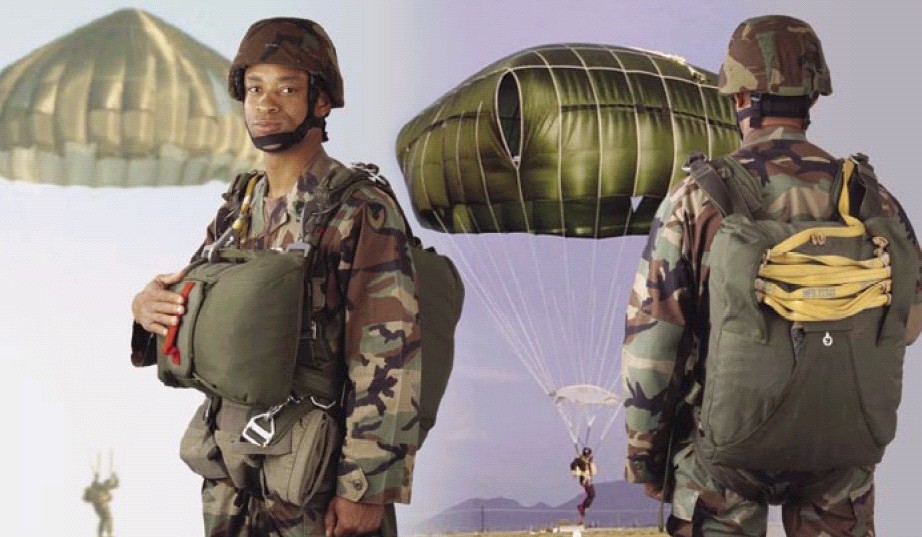
Early ATPS pic in wrong color still with shitty kit bag
We're not clear on whether T-11/T-11R will be in god awful Fulda Gap green as shown above or not, I hope not. Needs to be GRAY to blend into the sky.
T-11 and T-11R ATPS
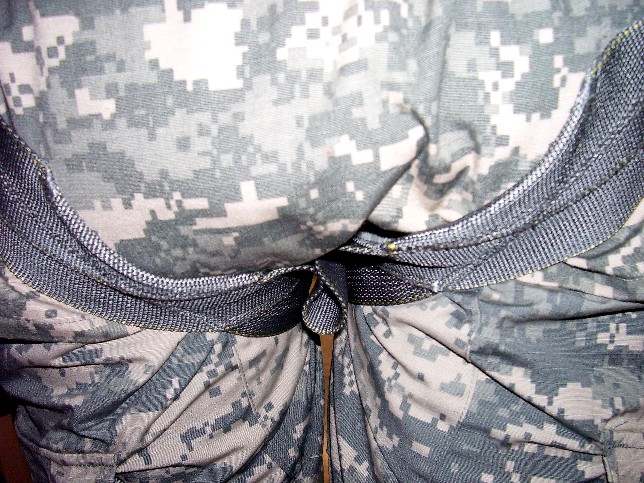
T-11 harness seems to have the legs straps sewn into a "V" so they separate away from your balls, hope its easier on your manhood than current straps converging at your groin.
Parachutist Drop Bag (PDB)
(shown on MFF jumper, ignore this it can work on T-11/T-11R, too)
Eagle Industries makes the PDB which is to carry the RUCKSACK you are using INSIDE and has a sewn-in HSPR system. Great idea to stop the rigging-your-ruck, HSPR clusterfuck.
The HSPR Clusterfuck Wrapping Your Rucksack
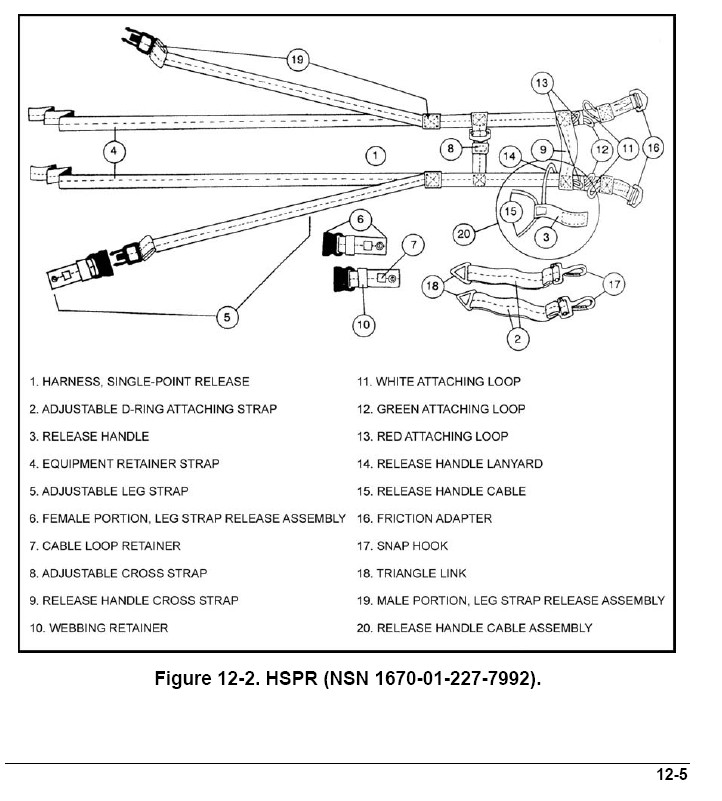
Its also in Army ACU camouflage which ironically a good color for blending into the daylight sky with its gray base color swatches.
www.infantry.army.mil/airborne/jumpmaster
www.infantry.army.mil/airborne/jumpmaster/rigging_PDB.doc
Rigging and JMPI of the Parachutist Drop Bag
The Parachutist Drop Bag (PDB)
The Parachutist Drop Bag is a lightweight nylon bag used to carry mission essential equipment to include field packs (ALICE, MOLLE, SPEAR) during airborne operations.
Rigging loads in the parachutist drop bag
Loads in the parachutist drop bag are rigged as follows:
Attaching the Parachutist Drop Bag to a Jumper
The parachutist drop bag is attached to the jumper in the same manner as the Harness Single Point Release System. Ensure that the excess of the adjustable "D" ring attaching straps are secured in the webbing retainer provided.
JMPI of a jumper wearing the parachutist drop bag
a. After issuing the jumper the command of hold for the reserve parachute the jumpmaster will place his left hand on the snap hook for the right adjustable "D" ring attaching strap and his right hand on the snap hook for the left adjustable "D" ring attaching strap. The jumpmaster will focus his attention on the left hand and the right adjustable "D" ring-attaching strap. With the index finger of the left hand finger the opening gate one time to ensure that the right adjustable "D" ring attaching strap has spring tension, is facing towards the jumper, and is to the outside of the connector snap for the reserve parachute. Place the left index finger on the front of the adjustable "D" ring-attaching strap just below the snap hook. Trace down the right adjustable "D" ring-attaching strap until contact is made with the black attaching loop, ensuring that the adjustable "D" ring-attaching strap is not twisted, cut, torn, or frayed. Once contact is made with the black attaching loop ensure that it is routed from bottom to top through the triangle link, that the white attaching loop is routed from bottom to top through the black attaching loop, and that the red attaching loop is routed from bottom to top through the white attaching loop. Further ensure that the red attaching loop is routed from bottom to top through the grommet on the female portion leg strap release assembly. Place the left index finger on the three-point "W" stitch of the release handle cross strap and look at the release handle cable. Ensure that the release handle cable is routed between the two plies of the release handle cross strap, through the red attaching loop and secured in the cable loop retainer. Leave the left index finger in place and conduct the same inspection with the right hand on the left adjustable "D" ring-attaching strap. Leave the left hand in place and with the right hand gently lift up on the release handle to ensure that it is routed between the two plies of the release handle cross strap and that it is secured by the hook and pile tabs provided. Grasp the PDB by its side, raise it up to the jumper, and issue the command of hold. With the left hand palm facing the PDB thumb pointing down grasp the parachutist drop bag lowering line in the vicinity of the girth hitch. Tug up on the parachutist drop bag lowering line ensuring that the parachutist drop bag lowering line is girth hitched to the triangle link. Place the right index finger on the hook and pile tabs on the right side of the retainer flap. Ensure that the parachutist drop bag lowering line enters the retainer flap from the right side, that the hook and pile tabs are secured, and that no folds of the parachutist drop bag lowering line are protruding from the retainer flap. With the right index finger trace across the retainer flap ensuring that the hook and pile tape is secured until you make contact with the hook and pile tabs on the left side of the retainer flap. Ensure that the hook and pile tabs are secured and that no folds of the parachutist drop bag-lowering line are protruding from the retainer flap. With the right index finger continue to trace the parachutist drop bag lowering line until the index finger disappears behind the nylon chafe of the M1950 weapons case ensuring the parachutist drop bag lowering line is not cut, burned or frayed. With the left hand grasp the trail edge of the M1950 weapons case and pull it towards you. Remove the right index finger and place it on the parachutist drop bag lowering line on the opposite side of the M1950 weapons case. Continue to trace the parachutist drop bag lowering line to its point of attachment. Ensure that the opening gate of the ejector snap of the parachutist drop bag lowering line is facing towards the jumper. With the right thumb physically seat the activating lever of the ejector snap to ensure that it is seated over the ball detent and free of foreign matter. Make a visual inspection of the yellow safety lanyard to ensure that it has not been wired, tied or taped down. With the right hand turn the ejector snap 1/4 turn out and look at the small tooth of the ejector snap to ensure it is present. Place the right index finger on the surgeon's knot locking knot of the lowering line adapter web tie to ensure that the lowering line adapter web tie is secure. With the right index finger trace the lowering line adapter web up until it disappears ensuring that it is not twisted cut torn or frayed. Move back to the front of your jumper and issue the command of squat. The remainder of the jumper will be inspected as if they were a hollywood jumper.
Even better, when you are done with the PDB you turn it inside out (to retain all the HSPR strappage) AND USE IT AS A KIT BAG TO RECOVER YOUR T-11 and T-11R! No more BS kit bag under your leg straps!
DECLUTTER THE PARATROOPER!
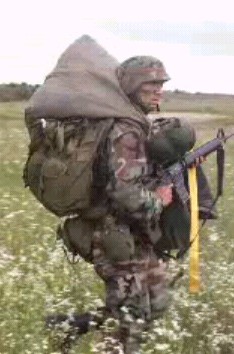
The PDB depicted here is the "medium" version, a "large" version might be able to carry a LAW or SMAW-D rocket. If not, we need a new M1950 type case that can also carry a M16/M4 and a LAW or SMAW-D to avoid the atrociously large AT4 jump pack clusterfuck.
The PDB will streamline the Paratrooper for a better aircraft exit and improve safety with less to snag on. It gets rid of the gawdawful kit bag, saving weight and simplifying things.
EDITOR: here's jump footage from the Airborne/Special Operations Test Board of static line parachute jumps that could also be shown:
BAD JUMPS: BAD JUMP EQUIPMENT, BAD JUMP PROCEDURES AND BAD JUMP PRACTICE
GOOD JUMPS: STILL BAD JUMP EQUIPMENT, BAD PROCEDURES BUT PARATROOPERS FEND FOR THEMSELVES
If we are going to make any headway in the Airborne operation, we have to de-clutter it...we need an Advanced Tactical Parachute System ATPS and get that reserve off our front!, and have the new parachute's rip cord in the harness itself (right side) covered by a velcro and snapped flap. Just prior to jumping, the flap is unwrapped and secured in the open position. This reduces the risk of accidental reserve activations while en route. Recently (2000) an Army JumpMaster doing jumpdoor checks was killed when his reserve ripcord snagged; all preventable if the ripcord was covered and flat against the chest instead of bulging out on a huge reserve asking to be activated. Now, the rucksack can take the place of the "lump" at your belly, freeing your legs so you can shuffle and walk out the door unencumbered, reducing the risks of bad exits, being towed, twists etc.
Ted Strong's version of a T-21 Parachute System
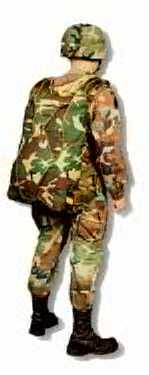
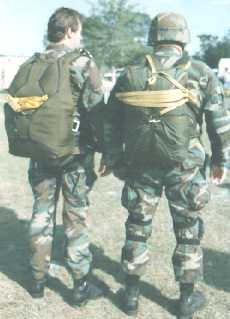
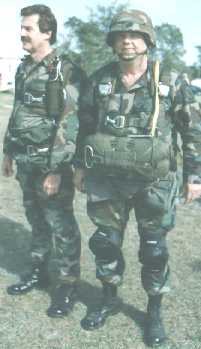
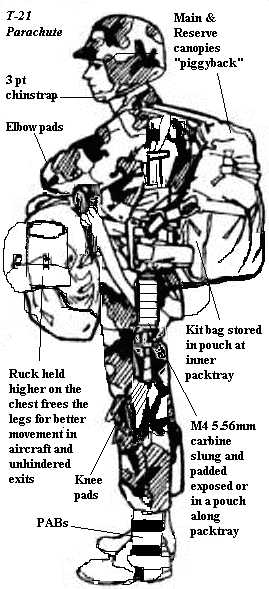
The T-21 should have an universal static-line that adjusts so it can be 20 feet long if jumping from a C-17 Globemaster III or a C-47 Skytrain, or can be shortened to 15 feet if the C-130 Hercules/C-141B Starlifter is the jump aircraft. One static-line for all aircraft so Riggers need not have to configure parachutes in order to have the right length static-line.
The cut-away red "beanbag" is on the other side of the harness (left) and one pull disengages the 3-ring assemblies holding the main and a reserve static-line (RSL) pulls open the reserve, however Paratroopers are still taught to pull the reserve rip cord. If a jumper has got a total malfunction, he can clear the tangled mess as his reserve is pulled open instead of risking the reserve getting caught up into the mess. Both bean bag cut-away and reserve rip cord handle are "dummy corded" to save the U.S. Army money and prevent field loss. In a normal landing, a "pelican clip" is pulled to disengage the RSL so the main canopy can be instantly cut away to prevent wind dragging without opening the reserve pack tray, pilot chute etc. This one-pull-release means faster exit from the harness into fighting order. In fact, the harness can be kept on since the main has cleared, only the rucksack on its lowering line dangles....the T-21's split-saddle legs straps do not hurt his circulation or are uncomfortable for long periods of time...
Built into the side of the packtray would be a velcro and Fastex quick-release buckle padded pocket/case to hold a compacted M4 5.556mm carbine..... the Paratrooper reaches back, opens the flap and grabs his M4 carbine ready to fight..
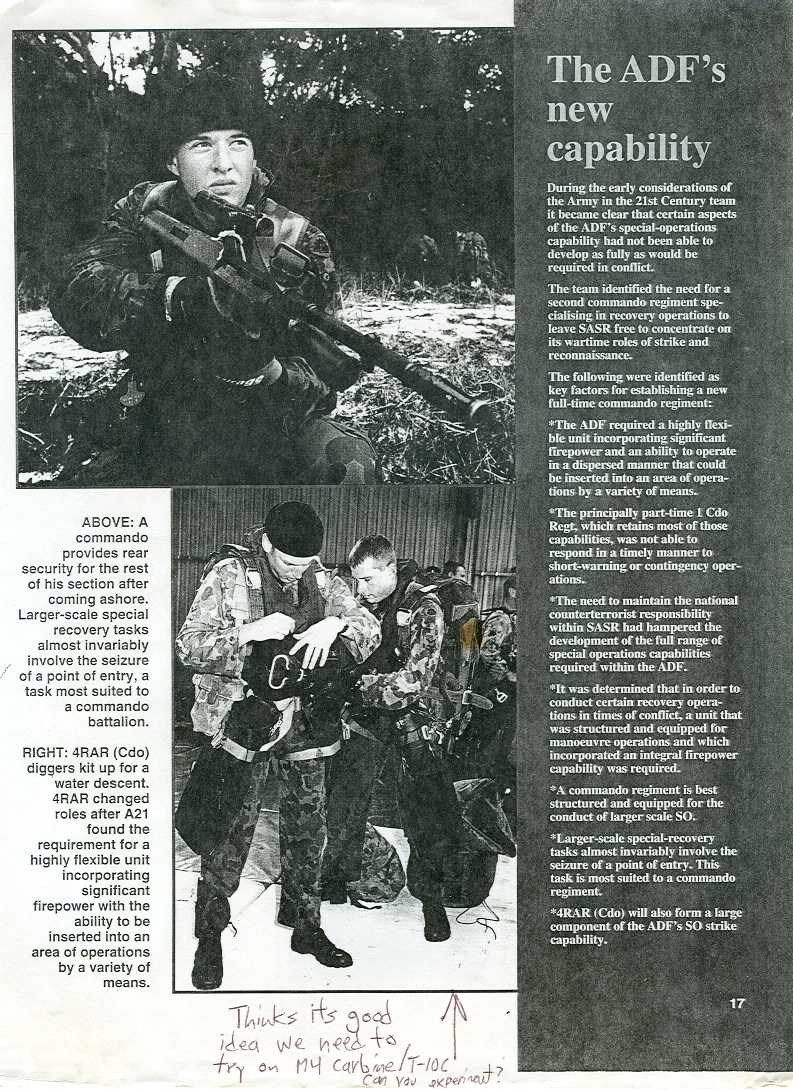
The photo is from Army Magazine, September 1997, official journal of the Australian Army, page 17 caption reads:
"4RAR (Commando) diggers kit up for a water descent. 4RAR changed roles after A21 found the requirement for a highly flexible unit incorporating significant firepower with the ability to be inserted into an area of operations by a variety of means".
The Russians can jump and fire their weapons on the way down, so can the U.S.: Russian Airborne Videos!
Note:
1. they jump in front of jet engines because they use drogue chutes not static lines and d-bags; as BMD goes out rear ramp they are jumping in front fuselage to land closer together
2. they can fire AKMs on way down under canopy (we can, too with M4 5.56mm carbines)
3. they have men IN the BMD to speed de-rig and placement into action
4. what they can do with BMD we can do even better with M113 Gavins/M8 Buford/Thunderbolts to give Paratroopers armored mobility/firepower/protection
...he disconnects his pelican clip that holds his HPT lowering line (Gen II Product Improved) and follows it to his rucksack which has a pull-the-dot quick release to free it for wear on the back. Donning his ruck, the Paratrooper leaves the drop zone rapidly......ready for battle!!!!
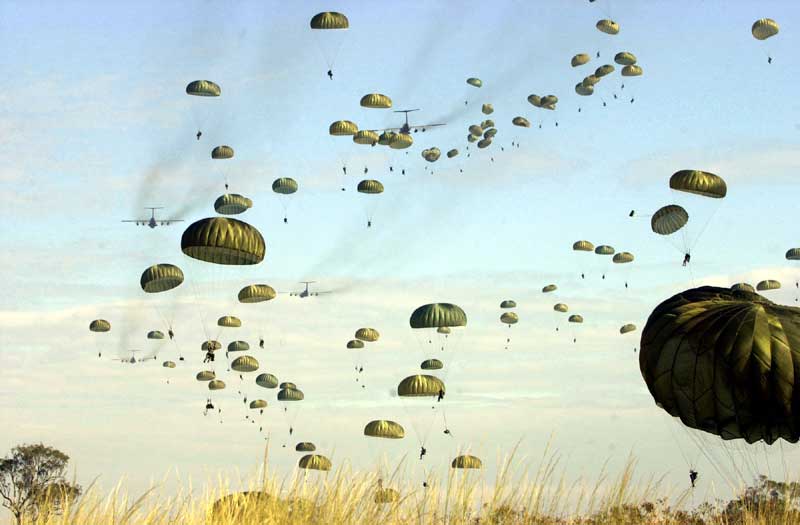
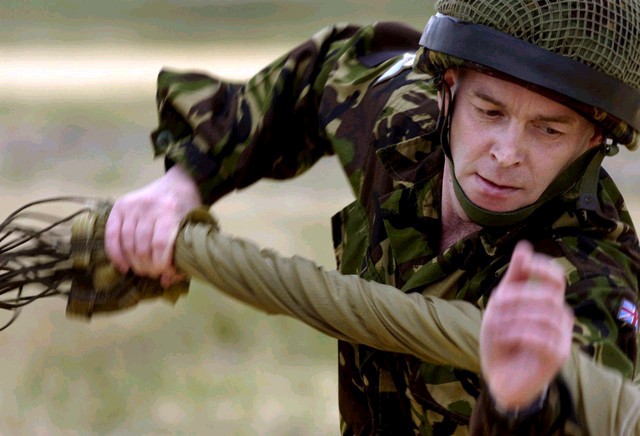
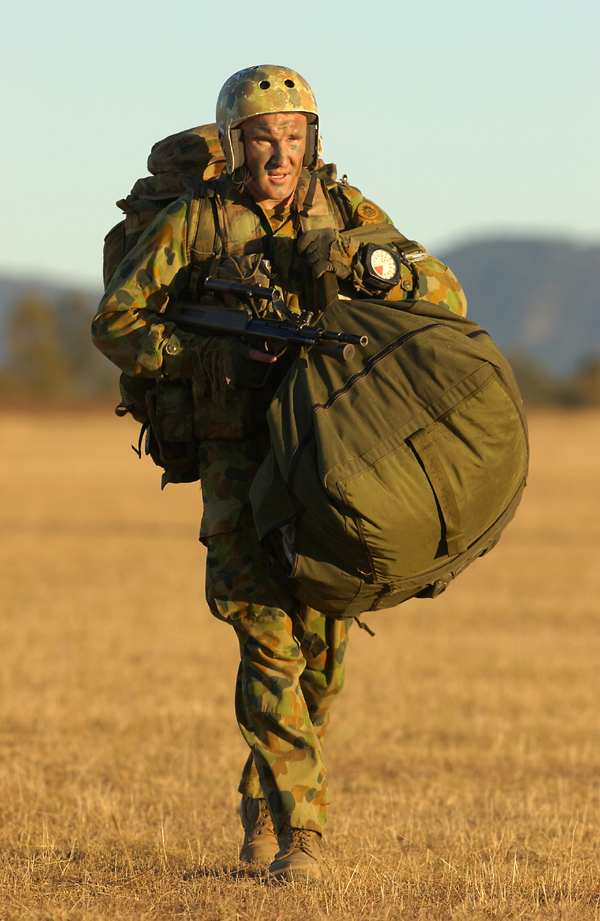
RECOVERING AIR ITEMS
Instead of running off with the harness on etc., he removes it by undoing his chest strap and two leg straps, places it on the ground...an inner pocket at his back holds his folded aviator's kit bag. If using the Harness, Single Point Release (HSPR), he recovers the D-ring attaching straps from the T-21 harness. He opens up the bag and places his harness and packtray inside, runs down to his excellent Irvin Low-Level Parachute (LLP) parachute that can open at 250 feet, and figure-8 rolls it into the kit bag. He can "ruck up" as before and carry the kit bag over his shoulder, M4 carbine slung, except he stuffs his Gen II HPT lowering line into his pocket, and removes his Parachute Ankle Braces (PABs) and places them in his rucksack since its a non-tactical situation.
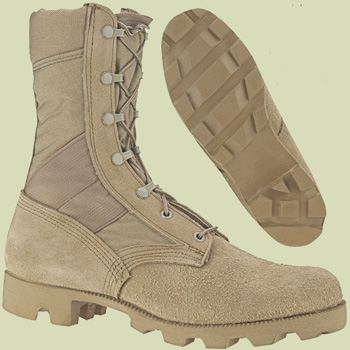
Jungle and Desert boots with their fabric sides can be stiffened by PABs for ankle support during jumps, yet removed right after the jump to regain their desirable lightweight (3.36 pounds compared to 4.2 pounds for full leather speed-lace boots) and quick drying and cooling capabilities. One of the conclusions from Operation Just Cause in Panama was that Paratroopers need an ankle protective brace:
" The authors conclude that methods of bracing to prevent injuries need to be considered, such as prophylactic ankle braces on high intensity night-time parachute operations."
PABs: Aircast Corporation
1-800-526-8785
PO 709, 92 River Road
Summit, NJ 07902
POC: Ms. Sue McKay;
http://www.Aircast.com
The benefits of a "Military Free-Fall/Ram-Air Parachute-type" integrated static-line round parachute system are too numerous to list. As described above, we eliminate/simplify:
* separate reserve parachute storing and packing
* the M1950 case and Air Pack weapons cases except for large weapons
* Simplify JMPI procedures to one parachute instead of two
This clutter elimination, allows in-flight rigging to be a possibility at all aircraft loading configurations-----64 in a C-130 Hercules not 44 due to the center aisle seats removed. In fact, 80-92 combat concentrated in-flight rigging is now possible with the C-130 since there are no reserves and M1950 weapons cases to deal with. Put the parachute on from under your seat, rig your rucksack and lowering line and you're good to go. Even if you board the plane in combat concentration with the T-21 parachute on, its split-saddle construction is comfortable enough that you can wear it for hours without discomfort since it pulls away from your groin....relieving yourself in-flight without having to be re-JMPIed is also a possibility. If the wheel well inside coverings were to be removed, 92 Paratroopers with streamlined T-21 parachutes should be able to fit=the same number that can be airlanded. These should all be able to jump via the reduced stress on the anchor line cables provided by the parachute kit bags staying with the canopy and not catching air and flopping hard to the rear of the aircraft.
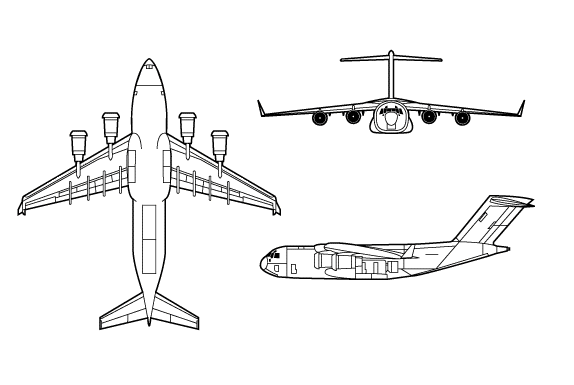
America's new, U.S. Air Force C-17A Globemaster III depicted above can airdrop paratroopers, CDS bundles and oversized loads like 3 x M113A3 Gavin armored fighting vehicles or up to a total of 170,300 pounds like the much larger C-5B Galaxy, to include parachute LVAD airdrop:
yet can land and take-off these loads (5 x M113A3 Gavins at a time) from 3,000 foot long dirt strips like the much smaller, though legendary C-130 Hercules....Its spacious 48" X 80" wide jump doors allow Paratroopers to exit with less risk of snagging....
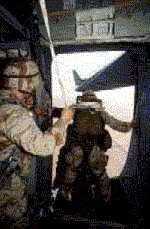
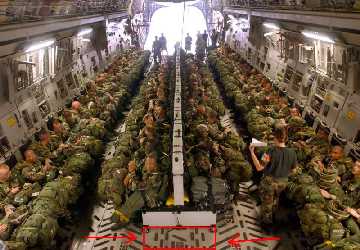
www.youtube.com/watch?v=gisje5UCfEU
More food for thought.......
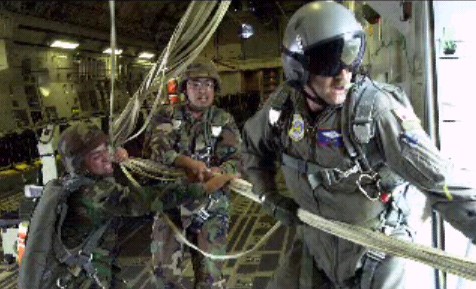
Have the canopy upon Paratrooper aircraft exit, keep its deployment bag (D-bag)....reducing greatly the aerodynamic drag acting upon the aircraft and simplifying the muscle needed to pull in static lines.....in fact......static lines-only, trailing from the aircraft means, the 2 x U.S. Army Safeties can now jump, the USAF Loadmasters can pull in the static-lines themselves, = more combat power for the U.S. Army on the ground. The Loadmaster can close the jump door faster so the aircraft can speed away from the DZ, reducing its exposure time to enemy fire.....For jumps no D-bags flopping around means safer exits. Overall, this means less stress on the anchor-line cables so more jumpers can exit per pass. Consider what Eastern European Airbornes do....
American "T" Series Parachutes dangle D-Bags out the Jump Doors
Unlike NATO parachutes, Russians parachutes do not have static lines or D-bags that hang out of the jump doors, slowing down the airplane and requiring two or more people to pull them in. The Russian D5/6 parachute has a drogue stabilizer chute, which is deployed when the Paratrooper exits the door. As he falls away from the airplane stabilized, he can deploy the main chute with a rip cord pull or by an automatic opening device. He can jump from aircraft much lower at 200 feet and much faster up to 300 mph, or at 12, 000 foot high altitudes using the delay-opening feature.
The 1995 bulletin of the International Airborne Society (IAS) at Fort Bragg, North Carolina states:
A long time has passed since Leonardo da Vinci first toyed with the theory of a safe descend from the heavens utilizing a suspended fabric device.
But evolution has not stopped, and developments in the area of military parachutes have taken some interesting turns. Since the end of the Second World War two main parachute systems have evolved utilizing two distinctly different modes of deployment. For lack of a better term I will refer to them as the "Western" and the "Eastern" system. The "Western system" primarily developed in the United States" includes the T-series parachutes and its various clones which are in service other western countries such as France, Italy, South Africa, and Israel.
On the other side of the spectrum we find the parachute's "Eastern" cousin, which has evolved into the D-series, primarily developed in the Soviet Union, and still in service with the Russian airborne forces and various other former Warsaw Pact nations. Other developments, functioning on the same principle, have emerged in the former East Germany (RS-9 series), Czechoslovakia (OVP series) and Yugoslavia.
As stated, the main difference between the two lines is the mode in which the main canopy is deployed.
While the "Western" system uses its static line to pull the deployment bag from the pack tray" and disconnects from the apex of the canopy after the chute and suspension lines have been completely removed from the D-bag, the "Eastern" system utilized its static line only to pull a Stabilizer (or drogue) chute from its D-bag. This stabilizer chute, which is about 3 ft. in diameter, upon release of the main pack fasteners pulls the packing sleeve containing the main canopy and suspension lines Polish Troops with D-5 Parachute from the pack tray. Once all suspension lines have been elongated, the packing sleeve slides off the main and canopy, allowing it to open.
Even though this sounds a bit more complicated, the opening time of the parachute is no greater than that of its "Western" counterpart. The "Eastern" system, however, offers some distinct advantages. Due to the use of a packing sleeve twisted risers and suspension lines are a rare occurrence. The use of the stabilizer also allows this system to be jumped from fast flying aircraft with airspeeds ranging up to 260 knots (300 mph).
A major advantage is that this system can be jumped from high altitudes (up to 12, 000 feet). The delayed opening is achieved by holding the main pack fasteners in their locking mechanism, which upon reaching a predetermined altitude, is released by an automatic opening device (AOD, KAP-3). As a secondary release option the jumper may also utilize a manual ripcord to activate the opening sequence.
Listed below are some of the comparative characteristics of the two lines of parachutes:
"Western" (T-10)-------"Eastern" (RS-9/2A)
SAFE DROP SPEED ...............50-150 kts. (172 mph) 70-260 kts. (300 mph)
MIN. DROP ALTITUDE.................300 ft.........................200 ft.
RATE OF DESCENT..................16-20 ft/s................14-15 ft/s
SYSTEM WEIGHT (Mn & Res)....38 lbs.........................45 lbs.
MAX SAFE SUSPED WEIGHT....360 lbs.....................290 lbs.
Sources: FM-57-230, 82nd Airborne Division Advanced Airborne School, NVA Handbuch fuer Fallschmjaeger, Fallschirmhandbuch RS-9/2A.
Today's VDV in Action
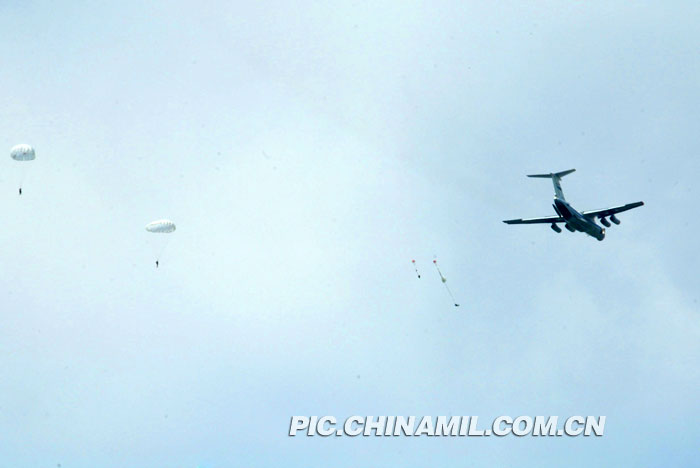
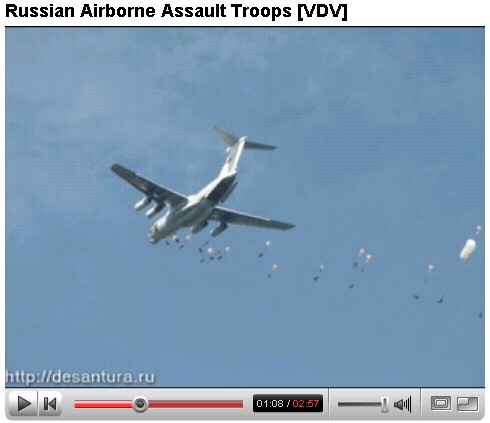
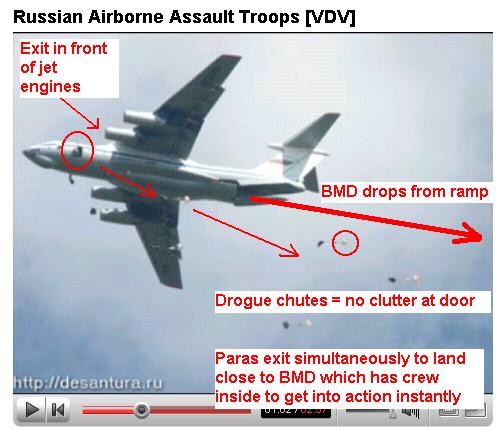
At the very least the next U.S. Parachute should have its D-bag detached and stay with the canopy if we do not go all the way and adopt the Russians stabilizer chute.
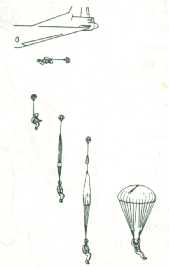 Drogue opening system
Drogue opening system
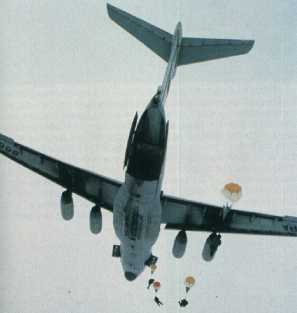 No D-bags trailing out the aircraft!
No D-bags trailing out the aircraft!
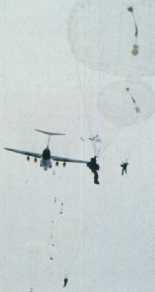 Russian mass-tac jump
Russian mass-tac jump
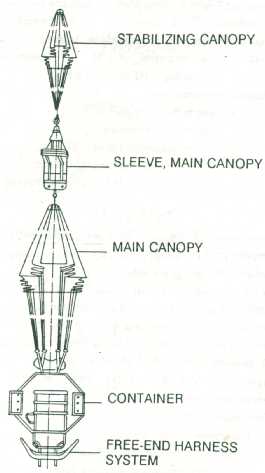 Parts of the D-5/6 system
Parts of the D-5/6 system
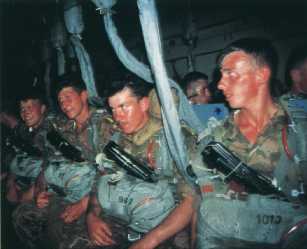 Russian Paratroopers hooked up, ready to jump in IL-76 jet aircraft
Russian Paratroopers hooked up, ready to jump in IL-76 jet aircraft
 Line art of Russian Paratrooper rigged to jump
Line art of Russian Paratrooper rigged to jump
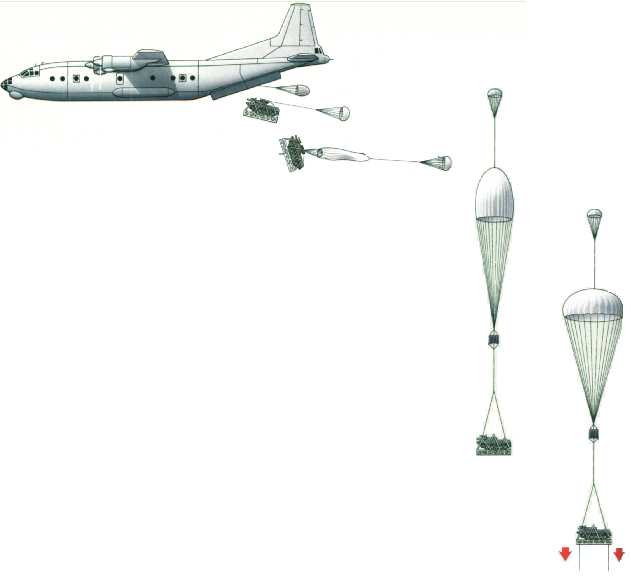 BMD light AFV jump sequence
BMD light AFV jump sequence
Russian Retro-Rockets = Less Parachutes to Deliver BMD Light Tanks
www.youtube.com/watch?v=4uGfOppQD_g
WHAT COLOR IS MY PARACHUTE?
One of the biggest concerns is the exposed position a Paratrooper is in descending under canopy. This can be minimized y jumping lower and CHANGING THE COLOR of the T-21 parachute to blend in better with the sky. I believe instead of dark olive drab we should go with a lighter color, but in probably an earth tone BROWN so on the ground, the canopies blend in with the soil/vegetation. The following picture has been modified to illustrate possible colors. What do you think? E-mail us. itsg e-mail addy
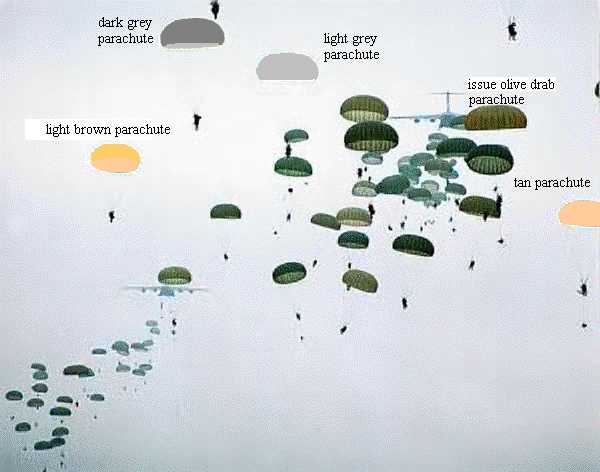

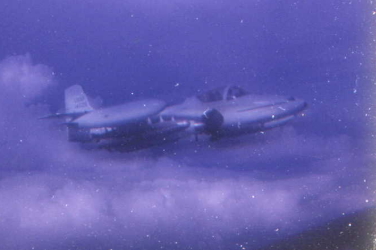
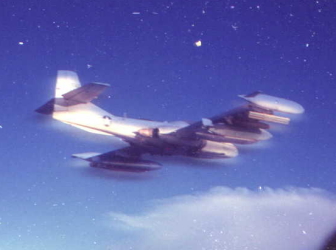

During the Vietnam War, USAF A-37B Dragonfly attack jets experimented with sky blue camouflage paint schemes, and it worked very well. Why not on Army parachutes?
While the stupid U.S. Army continues to fly "Fulda Gap" Green helicopters in broad daylight in desert tan Iraq IN ACTUAL COMBAT and then wonders why they are getting shot down, the enemy preparing for war camouflages its aircraft properly:
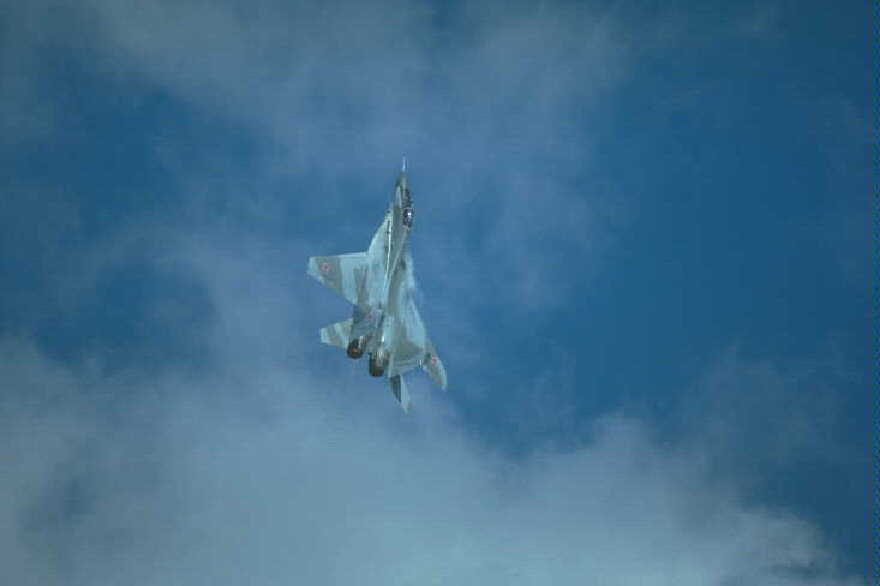
A South African ParaBat writes in:
From : xxxxxxxxxx
Dear Sir.
I would say the light grey parachute on the photo will be the best to use.We use TA300 systems that is also a light grey and even at night you can't see nothing. Normally at night you can see a green parachute coming down but the grey one not.
xxxxx xxxx.
South Africa.
BREAKING THE FALL, NOT THE PARATROOPER
Each year, dozens of people die when their parachutes--main and/or reserve fail to function. We can deny it all we want but it happens. Now are we going to DO SOMETHING ABOUT IT?
Recently I saw a video clip of a man who had a helmet camera on as he fell to the ground with a total malfunctioned pair of canopies overhead (why can't the reserve be a round canopy so unlike another ram-air canopy it will not fly into a tangled main and have some deceleration effect?). He hit the ground and lived. Not only that he got up and walked away. The report sited him being relaxed when he hit and the soft muddy ground.
Years ago, I fell 4 stories after my scaffolding broke doing vinyl siding. As I fell I was in denial and relaxed. I hit the ground and got up uninjured, though I quit that job immediately!
The point of all this is tha humans CAN survive falls if they can get some "breaks", just a bit of deceleration above them by at least a partially open parachute and some cushioning from vegetation or snow below.
It is my contention that we can make our own "muddy" surface to land by inserting a layer of shock-dampening honeycomb cardboard into the packtray of parachutes so in event that of total malfunction of main/reserve the jumper falling back first could land with just injuries not death, and in some cases no injuries. Stuntmen have long fallen into cardboard boxing to achieve the same, effect, honeycomb is just a compact form of the same principle. A piece of 3" honeycomb as used by the military to cushion vehicles and equipment for air-drop could be inserted into an inner pouch of the parachute packtray and be easily replaced if crushed during use. Such a pad should be integral to all military parachute systems and the insides of rucksacks in case a Soldier falls off a fast rope so he is not injured or at least not killed. Such pads should be offered as vests for mountain climbers, construction workers, telephone pole repairmen etc. so they, too can have a needed break for a possible fall.
VIDEO PROOF:
The good news is that if your main parachute fails, PLAN "A" and your reserve fails PLAN "B", too it usually means there's a tangled mess above you which IS still catching SOME AIR and decelerating your fall SOMEWHAT. If shock-absorbing honeycomb was at your back and you had a PLAN "C" of a small inflatable square air bag, you could survive such a fall as this segment of TDC's "Mythbusters" shows with a large inflated bag but without shock-absorbing honeycomb. The facts are that people HAVE survived main/reserve parachute malfunctions if they get some help in cushioning the fall by landing in trees, mud or snow--so why not always have this life-saving cushioning?
Russian Airborne Air Bags: Replacement for Retro-Rockets?
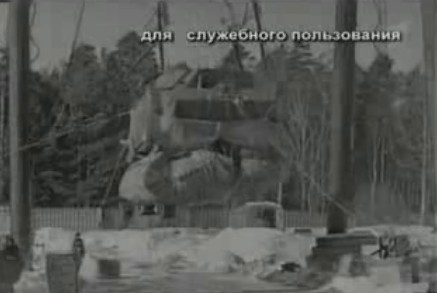
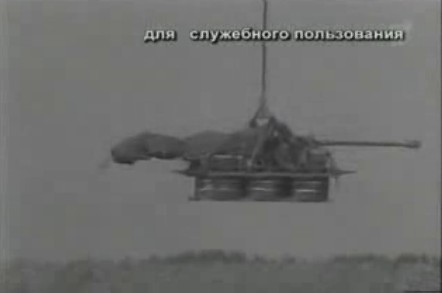
Now then, some will immediately complain that a 3" honeycomb layer would NOT totally defeat a 120 mph fall and return us to the status quo, which is NOTHING. If you have your parachutes fail you, you have NOTHING. A layer of honeycomb is better than nothing, in fact in most cases some parachute opens above-----that honeycomb could all that is needed to save a life. Certainly, it would help in cushioning hard landings when the parachutes open as designed, too! In a military setting, a layer of honeycomb on the back protects the paratrooper if dragged by the wind. Another possible application would be a layer of honeycomb on the bottom of the boots to eliminate that ground shock if jumping onto runways.
Air Bags Can Save Lives in Event of Total Parachute Failure
We are only talking about less than 100 mph in descent in the very worst case and more likely half that which is like a motorcycle crash--enough padding and air bag deceleration for this equals not just lives being saved but lives being restored back to full health afterwards. Too bad if it defecates on "blood on the risers" Paratrooper self-creating fatalism and egotism, AIRBORNE WARFARE IS ABOUT GETTING TO THE GROUND FIT-TO-FIGHT AND GETTING THE JOB DONE not whining about how tough air delivery is because we don't take steps to improve jump warfighting technology.
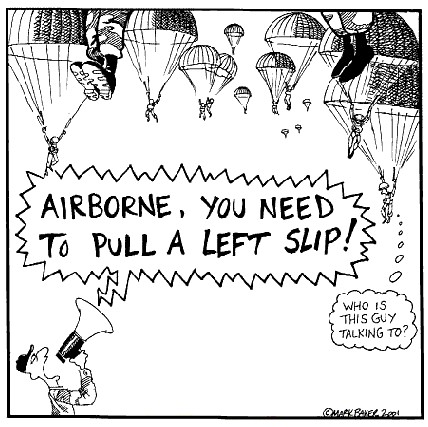
Defeatists and closed-minded thinkers should not be listened to here. If honeycomb helps cushion vehicles and equipment why not humans? We are being silly not to FULLY explore the potential of a mere few ounces of honeycomb cardboard from rendering us ZERO deaths in the world of parachuting and military Paratrooping.
Have every Paratrooper wear a wrist compass so he can quickly converge on their assembly points----Tekna and Suunto make the best. Natick Labs are working on a wrist homing device to achieve a better effect using a homing signal at the assembly point. It "looks like a Dick Tracy watch," Army Material Command spokesman Gibson said. A transmitter the size of a soda can is located at an assembly point, attached to the key leader or a crew-served weapon or vehicle. The transmitter emits a specific code that is picked up by a wristwatch-size receiver and guides paratroopers to their target. Tests of the device have recently been completed and the contractor is making final adjustments, Smith said.
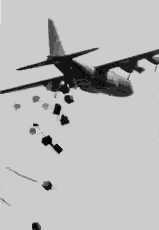
Those that jump sport RAPs and especially military Free-Fall jumpers need to stop keeping the integrated piggyback parachute harness a secret to themselves, as their brethren jump at best 1960s technology. Industry needs to aggressively sell "stick-in-the-mud" types in the U.S. Airborne community that they are not even close to "arriving"; that military static-line parachuting has a vast area that needs to be improved.....that our forebears; Generals Gavin, Ridgway, Yarborough if on active-duty today would be "kicking us in the pants" today for these things. Damn it, its time for us to fill these men's shoes and start leading the way forward---LEADERSHIP----not just loud-mouth posturing and badge protecting------THAT IS COMBAT READY FROM THE DROP ZONE!!!!!!! The lives of our men, and victory in battle to defend the freedom of the world DEPENDS ON THE AIRBORNE!!!!!
America is a strategic AIR power as England was once a sea power.....
AIRBORNE!!!
The latest Safety Bulletin is below describing how an accidental ripcord activation killed a Jumpmaster in training.
Clearly:
1. Reserve ripcord in the center (French Paras have this) is better than on the right since it protects it better from acccidental activation---if one arm is injured, allows ambidextrous deployment is possible.
Jump training would have to change (too bad, lives are more important than laziness)
2. Get the reserve off the front!!! New T-21 parachute should have COVER FLAP over reserve rip cord handle and entire reserve integral with main at the back.
PARACHUTE FATALITY
A fatal accident occurred when a Modified Improved Reserve Parachute System (MIRPS) worn by a Jumpmaster student performing duties at the Paratroop door of a C-130 Hercules aircraft accidentally activated.
Jumpmasters are again reminded of the necessity of remaining in the center of the Paratroop door when performing Jumpmaster duties and particularly when attempting to return back inside the aircraft after conducting the clear to the rear of the aircraft. Jumpmasters must be aware that when returning back inside the aircraft, there is a possibility that the wind will force the body toward the trail edge of the aircraft. Jumpmasters must particularly resist this wind-effect when performing duties on the right Paratroop door because this potentially places the ripcord grip of the MIRPS in the vicinity of the trail edge of the Paratroop door. It is imperative that the ripcord grip does not come in contact with the lead or trail edge of the Paratroop door. The Safety should be observing the inside of the aircraft for unsafe acts when the Jumpmaster performs a clear to the rear and should also observe the Jumpmaster. If the Jumpmaster's ripcord grip comes near or touches the trail or lead edge of the paratroop door, the Safety should tell the Jumpmaster of the deficiency after he comes back into the aircraft and before the next clear to the rear. The Safety should never attempt to grab or interfere with the Jumpmaster while the Jumpmaster is outside the aircraft or attempting to return inside the aircraft.
This is the second time since FY 97 that the accidental activation of a Jumpmaster's reserve parachute caused a premature exit resulting in a fatal injury. All Jumpmasters and jumpers are again reminded to remain aware of their equipment inside the aircraft and ensure they utilize proper ripcord grip awareness.
Other lessons learned from this accident:
- Jumpmasters must select individual hand placement where they can maintain stability while conducting a clear to the rear ensuring the ripcord grip does not come in contact with the Paratroop door. Jumpmasters should position their hands in order that when returning into the aircraft after each clear to the rear that they not "brake" the trail elbow down and force themselves into the trail edge of the Paratroop door. After determining the proper hand placement, Jumpmasters should resist repositioning their hands after each clear to the rear.
- The Jumpmaster student was at the right Paratroop door and had the left adjustable leg strap on the Harness Single Point Release routed around the leg and the M1950 weapons case IAW the 82nd Airborne Division ASOP Edition 5 with Change 3, Chapter 9, page 9-10. Adjustable leg straps must be secured so as to prevent undue movement of the ALICE pack due to wind and / or contact with the aircraft to include the Paratroop door.
The information contained in this safety bulletin will be briefed to all Airborne Soldiers.
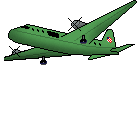 To go to Para-Digger's web pages...
To go to Para-Digger's web pages...
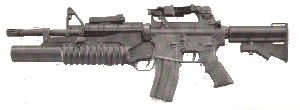 To return
to PARATROOPER 2000 click on the M4 5.56mm Carbine with M203 40mm grenade launcher......
To return
to PARATROOPER 2000 click on the M4 5.56mm Carbine with M203 40mm grenade launcher......
 To return
to 1st Tactical Studies Group (Airborne) home pages click on the U.S. Army Airborne wings...
To return
to 1st Tactical Studies Group (Airborne) home pages click on the U.S. Army Airborne wings...